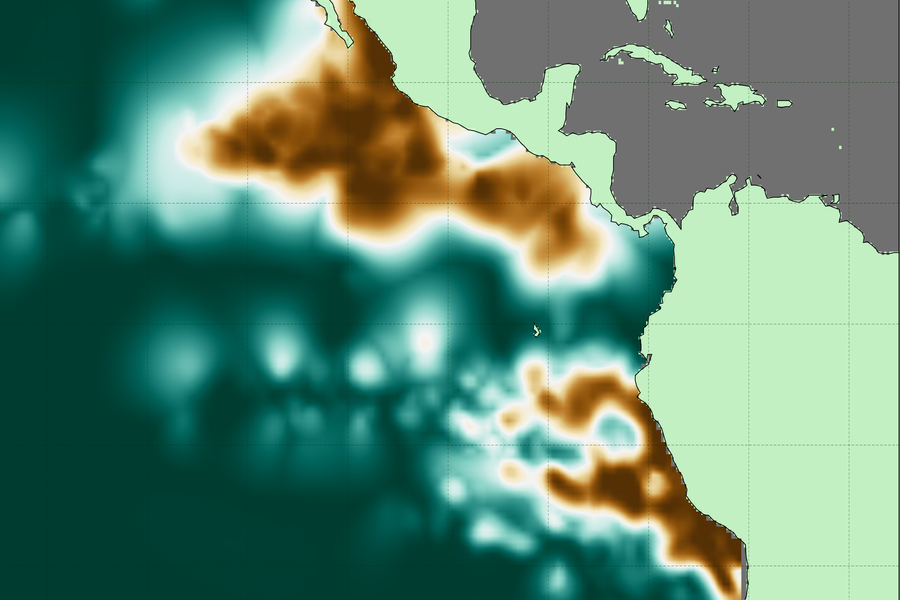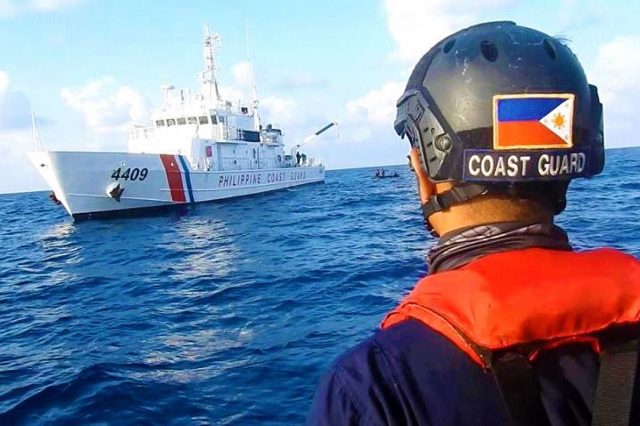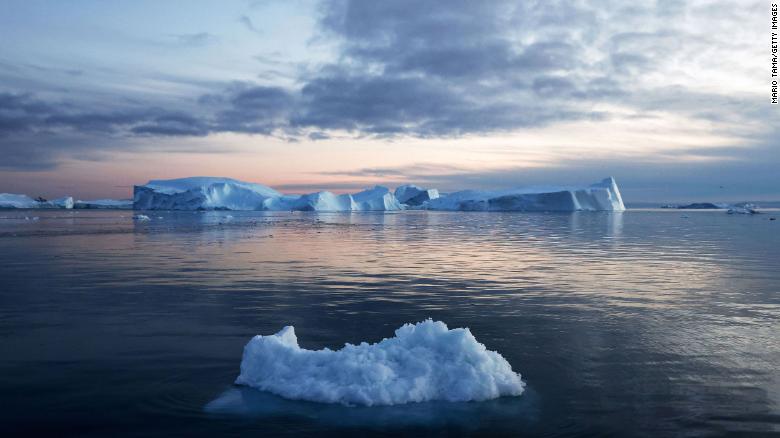Saturday, January 1, 2022
2022
Friday, December 31, 2021
How to build the ultimate superyacht for isolating on board

From BoatInternational by Elaine Bunting
Escaping from the world is always possible on a yacht.
Now, says Elaine Bunting, many owners want to live and work aboard for even longer
One of the unforeseen consequences of being locked down for much of 2020/2021 was that owners spent more time on their yachts – if they could get to them.
One-week trips to the boat were being extended to two or three weeks, and some owners even chose to ride out the worst of the pandemic on board.
Charters, too, were affected, with brokers reporting that while bookings were down, charterers were taking trips for longer periods.
This shift in usage has demanded new thinking from the superyacht industry.

“[Covid-19] has brought it home to people that they can spend more time on board if they need to,” says designer Jonny Horsfield.
His company, H2 Yacht Design, is behind long-range yachts such as 63.7-metre explorer vessel Scout and REV Ocean, a 182.9-metre expedition vessel that, when delivered, will become the world’s largest superyacht.
The studio’s portfolio also includes 75-metre Feadship Arrow, launched last summer, and 123-metre Lürssen Al Lusail from 2017.
“Generally speaking, I would say the interesting new yachts are much as they were a year ago but with more comfort, storage and supplies,” he observes.
“People are looking for a more casual solution to comfort rather than concentrating so much on what is normal or good for charters, and they wish to customise a little more.”
Storage, Horsfield says, is often compromised in order to squeeze in extra guest space.
Next-generation yachts fit for longer-term living will need more.
“I don’t think there’s a [specific] figure you need, it’s just more important to get it right than in the past,” he adds.
Read on for more tips for enjoyable longer spells on board.
Upgrade the onboard office

Credit: Burgess
“More people are working remotely, especially now they have seen that it works really well,” says sailing yacht designer Bill Dixon.
“Video conferences have improved immensely so maybe travelling for work will become the second option.
Owners can actually spend time on their yacht and work and earn money.”
At the extreme end of what is possible, REV Ocean is fascinating, designed to operate independently for months in remote areas from the Arctic to the Antarctic, and be interchangeable with an office environment ashore.
“You could run your entire business from that yacht,” says Jonny Horsfield.
“It has a functional business centre and a recreation of the owner’s entire office.
We have allocated a whole office suite and a trading room where you can have six guys on screens, as well as a massive conference room that can seat 35 directors where you can have board meetings – and they can all stay on board. It’s massive, bigger than most companies’ offices.”
The nature of boats was starting to change before the pandemic and this is now happening more rapidly, says Canadian naval architect Gregory Marshall.
“What we are seeing is a lot more self-contained long-range boats being away for four to six months.
This is a definite shift, and it’s across the board from 25 and 26 metres to our largest extended range project of 82 metres and everything in between."
“More than 50 per cent of clients consider their office [in the design] and we have certainly been doing more video conference rooms and more common spaces off a sky lounge rather than the owner’s suite so people can sequester themselves in that.”
Create dual-use spaces to maximise what you can do

Credit: Giuliano Sargentini
A yacht is all about enjoying downtime, family time and holidays, and there will continue to be a need for flexible, multi-use spaces.
Designer Tim Heywood thinks that the experience owners and their families had of isolating on yachts gave some “the opportunity to turn hard times into a diverting and potentially enjoyable experience.”
With that in mind, size matters.
“It is possible to enjoyably isolate aboard a moderately sized yacht of, say, 30 metres, but to take a sizeable family with back-up staff and full health facilities, I would aim for something in the region of 70 to 90 metres with a touch-and-go helipad.”
For longer periods it is paramount, Heywood feels, to have facilities to keep family and guests entertained.
“You need a saloon that can double as a cinema, if you don’t have a cinema planned, and a dining room that is equipped with conferencing facilities.
Children’s play and craft rooms and additional gym equipment are all facilities that should be maximised.”

Credit: Jeff Brown/Breed Media
The 83-metre Amels Here Comes The Sun, 68-metre Amels Neninka (previously Aurora Borealis) and 86-metre Oceanco Seven Seas are examples of superyachts that have cinemas that can be used as lounges, and a growing number of yachts, including recently delivered 80-metre Artefact, feature a play and craft room for children
The same applies outdoors, which can also be set up for multi-use, with more flexible arrangements than the normal fixed sofas and sunbeds, “allowing different layouts to add surprises to every day”, says Heywood.
Laura Pomponi, founder and CEO of Luxury Projects, says that versatile, convertible areas are more in demand than ever.
Lounge areas that can become a cabin, a gym that can be turned into a recreation area or an office, or a beach club that can be a cinema are all examples she cites.
Amenities such as balconies, saunas, spas and gyms are prized, particularly when guests are restricted in going out or have time on their hands, and convertible areas allow the living space to be varied.

Credit: Francisco Martinez
Pomponi and other designers say clients have been asking for a more homely, residential feel.
That means comfy sofas, high-end AV systems and high-speed communications.
It might also mean a different interior style.
“The minimalism we have seen in interiors in last few years with lacquered surfaces and strong contrasts doesn’t work any more,” Pomponi says.
“We are back to veneers, warm light, linen fabrics and calm tones.”
Gregory Marshall agrees that there is a move away from elaborate interior styling, driven by the wish for a cleaner aesthetic.
“In the last few months people have settled into the concept of being germophobes, and that is changing interior design itself,” he observes.
“People want fewer nooks and crannies that are hard to clean.”
Invest in better systems

Credit: Feadship
“Family is one thing. Friends? Well, you know what they say: after a week, friends are like fish, they go off!” says the owner of a 41-metre explorer when asked for his advice on spending long periods on board. You need “a good chef who makes every meal an interesting part of the voyage, and one who takes into account each of the guests’ particular needs.”
Asked what else he would recommend, he replies: “Good separation of owner, guests and crew, tenders that are multifunctional and seaworthy, enough fuel at cruising to cross the Atlantic and Pacific Oceans from, say, the US and full displacement and the ability to handle rough conditions.
Also, living areas that feel warm and look warm in cold climates, and a lot of spares and backups.”
But if good food is essential, the facilities and systems that make it all possible longer term need to be planned in a new build or refit.
In more remote places without regular access to shore, where crew can’t be flying in food from all over the world, thought has to be given to how food would be stored using extended fridges and freezers.
You need more, and bigger, storage, perhaps also rubbish and waste-handling systems, plus bigger tanks for fuel and black water.
.jpg)
Credit: Luxury Projects
Daniel Nerhagen, from Swedish studio Tillberg Design, has worked on the build and refit of superyachts from 72-metre Serenity and 69-metre Saluzi all the way up to cruise ships.
A point he makes is that cold storage allocation for provisions and rubbish is critical for independence but seldom easy to create in an existing vessel.
“On many yachts we have a very long range with fuel to be at sea or at anchor and that is not a challenge.
But most are used to being able to restock every week,” he says.
“With the Covid-19 situation, yachts were parked outside the harbours and crew were not allowed ashore.
That led to challenges, as they didn’t have the space.”
So what can be done on existing yachts?
bis.jpg)
Waste-handling systems area also becoming more sophisticated.
They are widely used on cruise ships, which can generate up to 10,000kg of rubbish and solid waste every day.
“To recycle food waste you can get machines that remove the water and dry the organic material, turning it into powder, and you store that in boxes,” Nerhagen says.
“All these waste-handling and compaction systems are available but you need to allocate space for them.
Most yachts don’t have it and it is hard to retrofit.”Nerhagen observes that new regulations and standards in the cruise industry are resulting in older vessels being scrapped.

Credit: Tom Van Oossanen
Easy, fast access from shore is another essential requirement when living on board for longer periods.
Yachts need to carry good tenders, preferably covered.
For larger yachts travelling to new destinations, or away for longer, a certified helipad becomes important.
“We are definitely seeing much bigger toys on board for going to remote places,” says Gregory Marshall.
“If you want to do a 200-mile trip you need a tender that can do that.
The 82 metre we’re working on packs an 18-metre tender.”
Another consideration for ensuring smooth running for a longer period is crew rotation, which can have an impact on the space set aside for crew quarters.
“It’s not always high on the list of priorities,” says designer Jonny Horsfield, “but you need to think about how the crew are being looked after.
A lot I know are confined to the yacht and it is not great for them so the idea of having more space would be good.”

None of these changes necessarily demands a new build.
Royal Huisman recently redelivered 56-metre Feadship Broadwater with a brief to turn her into “a modern and liveable home from home.” To achieve this, the transom was removed and the yacht extended by four metres and given a restyled stern with an aft deck and beach club.
Outdoor amenities include a new hot tub on the sundeck and a bar.
The yard is working on a conversion of a 43-metre Ron Holland-designed ketch from 1993, Juliet, to hybrid propulsion.
This will allow more silent running and to take advantage of her fuel storage for longer periods away from port.
H2 is working with a client who is looking for more space and wants to lengthen an existing yacht rather than wait for a new build.
The project would cut the yacht in the middle and extend it by around 10 per cent, leaving the engine room intact.
Large doors opening out on to balconies will be added, and more space for the owner, with another suite, cinema, and bigger dining room, while the old spaces will now be office areas.
Get ahead in technology
.jpg)
Besides fostering changes in design thinking, the quest for independence could also drive interest in sustainability.
“This is a big topic and it comes up at every client meeting,” says Daniel Nerhagen from Tillberg Design.
“How can you be self-sufficient? Wind turbines, solar panels, battery packs and fuel cells – how to extend your range or reduce fuel consumption and run the generator for only a few hours per day.
“These systems require more space than traditional diesel engines so it’s always a question of your priorities.” But, he adds: “For many people, the technology is a showcase.
It will accelerate – that’s inevitable.”
Bill Dixon, of Dixon Yacht Design, specialises in sailing yachts, such as the 55-metre Dixon 175 and the 70-metre Project NewDawn.
The latter is something of a crossover, a sailboat with an easily handled free-standing rig that has similar accommodation to a motor yacht of the same size, and for a comparable cost.

Technology that regenerates power from self-propulsion is the future, Dixon believes.
“Where it really does key into self-sufficiency is that, if you have some sail power, you have a way of generating electricity.
As we know now, Black Pearl nearly runs the vessel if it is sailing at a reasonable wind speed.
I believe we will see a lot more of that.
People like the idea."
“Then there is taking the energy you generate and making hydrogen for fuel,” he adds.
“On one of my potential projects, a client has already investigated fuel cell technology.
In the scheme of things, a large yacht of 100 metres can go fast and generate a lot of free energy.
If you really want to do something incredibly special, this is the way to look at one future for large, eco-friendly superyachts.”
Explore new places

Don’t bet on it; you just have to look at the huge uptake in private jets.
“I think people will want to travel but to new destinations, which is why the range and ability to be away for longer is important,” says Dixon.
If anything it’s possible there could be an upsurge in the desire to spend more time exploring and visiting new places or more unusual destinations.
“Owners are not giving up free time; they need their holidays.
Leisure time is important,” agrees Daniel Nerhagen.
“A yacht is still probably the safest place you could be and where you can escape all the current situation.”
A yacht that has been refitted or built to create the right environment and spaces for longer-term living, working and relaxation will allow owners and guests to take maximum advantage of the new working-from-home culture.
Could such configurations eventually become a new norm?
.jpg)
“It is its own bubble,” remarks the owner of his 55-metre explorer yacht, who spends months at a time on board with his family.
“It protects you from some parts of the world and allows you to build a strong family bond.
There is no greater luxury than being on a yacht.”
Links :
- GeoGarage blog : A $50 million boat for the toys you can't fit on your yacht / Trade wars even scare the megarich – just look at Superyacht sales / Blue Planet gives super-rich their new toys – submersibles / Exploring the Arctic circle on board scientific superyacht Yersin / The $1 billion superyacht: Bigger, longer, but is it better? / World's largest yacht launched: the 183m REV Ocean / Norwegian billionaire funds deluxe deep ocean research ship
Thursday, December 30, 2021
Scientists build new atlas of ocean’s oxygen-starved waters
Credit: Jarek Kwiecinski and Andrew Babbin
The 3D maps may help researchers track and predict the ocean’s response to climate change.
Life is teeming nearly everywhere in the oceans, except in certain pockets where oxygen naturally plummets and waters become unlivable for most aerobic organisms.
These desolate pools are “oxygen-deficient zones,” or ODZs.
And though they make up less than 1 percent of the ocean’s total volume, they are a significant source of nitrous oxide, a potent greenhouse gas.
Their boundaries can also limit the extent of fisheries and marine ecosystems.
Now MIT scientists have generated the most detailed, three-dimensional “atlas” of the largest ODZs in the world.
The new atlas provides high-resolution maps of the two major, oxygen-starved bodies of water in the tropical Pacific.
These maps reveal the volume, extent, and varying depths of each ODZ, along with fine-scale features, such as ribbons of oxygenated water that intrude into otherwise depleted zones.
The team used a new method to process over 40 years’ worth of ocean data, comprising nearly 15 million measurements taken by many research cruises and autonomous robots deployed across the tropical Pacific.
The researchers compiled then analyzed this vast and fine-grained data to generate maps of oxygen-deficient zones at various depths, similar to the many slices of a three-dimensional scan.
From these maps, the researchers estimated the total volume of the two major ODZs in the tropical Pacific, more precisely than previous efforts.
The first zone, which stretches out from the coast of South America, measures about 600,000 cubic kilometers — roughly the volume of water that would fill 240 billion Olympic-sized pools.
The second zone, off the coast of Central America, is roughly three times larger.
The atlas serves as a reference for where ODZs lie today.
The team hopes scientists can add to this atlas with continued measurements, to better track changes in these zones and predict how they may shift as the climate warms.
“It’s broadly expected that the oceans will lose oxygen as the climate gets warmer.
But the situation is more complicated in the tropics where there are large oxygen-deficient zones,” says Jarek Kwiecinski ’21, who developed the atlas along with Andrew Babbin, the Cecil and Ida Green Career Development Professor in MIT’s Department of Earth, Atmospheric and Planetary Sciences.
“It’s important to create a detailed map of these zones so we have a point of comparison for future change.”
The team’s study appears today in the journal Global Biogeochemical Cycles.
Airing out artifacts
Oxygen-deficient zones are large, persistent regions of the ocean that occur naturally, as a consequence of marine microbes gobbling up sinking phytoplankton along with all the available oxygen in the surroundings.
These zones happen to lie in regions that miss passing ocean currents, which would normally replenish regions with oxygenated water.
As a result, ODZs are locations of relatively permanent, oxygen-depleted waters, and can exist at mid-ocean depths of between roughly 35 to 1,000 meters below the surface.
For some perspective, the oceans on average run about 4,000 meters deep.
Over the last 40 years, research cruises have explored these regions by dropping bottles down to various depths and hauling up seawater that scientists then measure for oxygen.
“But there are a lot of artifacts that come from a bottle measurement when you’re trying to measure truly zero oxygen,” Babbin says.
“All the plastic that we deploy at depth is full of oxygen that can leach out into the sample.
When all is said and done, that artificial oxygen inflates the ocean’s true value.”
Rather than rely on measurements from bottle samples, the team looked at data from sensors attached to the outside of the bottles or integrated with robotic platforms that can change their buoyancy to measure water at different depths.
These sensors measure a variety of signals, including changes in electrical currents or the intensity of light emitted by a photosensitive dye to estimate the amount of oxygen dissolved in water.
In contrast to seawater samples that represent a single discrete depth, the sensors record signals continuously as they descend through the water column.
Scientists have attempted to use these sensor data to estimate the true value of oxygen concentrations in ODZs, but have found it incredibly tricky to convert these signals accurately, particularly at concentrations approaching zero.
“We took a very different approach, using measurements not to look at their true value, but rather how that value changes within the water column,” Kwiecinski says.
“That way we can identify anoxic waters, regardless of what a specific sensor says.”
 CTD-rosette of Niskin bottles capable of collecting water at depth and making continuous oxygen measurements.
CTD-rosette of Niskin bottles capable of collecting water at depth and making continuous oxygen measurements.The team reasoned that, if sensors showed a constant, unchanging value of oxygen in a continuous, vertical section of the ocean, regardless of the true value, then it would likely be a sign that oxygen had bottomed out, and that the section was part of an oxygen-deficient zone.
The researchers brought together nearly 15 million sensor measurements collected over 40 years by various research cruises and robotic floats, and mapped the regions where oxygen did not change with depth.
“We can now see how the distribution of anoxic water in the Pacific changes in three dimensions,” Babbin says.
The team mapped the boundaries, volume, and shape of two major ODZs in the tropical Pacific, one in the Northern Hemisphere, and the other in the Southern Hemisphere.
They were also able to see fine details within each zone.
For instance, oxygen-depleted waters are “thicker,” or more concentrated towards the middle, and appear to thin out toward the edges of each zone.
“We could also see gaps, where it looks like big bites were taken out of anoxic waters at shallow depths,” Babbin says.
“There’s some mechanism bringing oxygen into this region, making it oxygenated compared to the water around it.”
Such observations of the tropical Pacific’s oxygen-deficient zones are more detailed than what’s been measured to date.
“How the borders of these ODZs are shaped, and how far they extend, could not be previously resolved,” Babbin says.
“Now we have a better idea of how these two zones compare in terms of areal extent and depth.”
“This gives you a sketch of what could be happening,” Kwiecinski says.
“There’s a lot more one can do with this data compilation to understand how the ocean’s oxygen supply is controlled.”
This research is supported, in part, by the Simons Foundation.
- Scientific American : Marine Oxygen Levels are the Next Great Casualty of Climate Change
- EOS : How the Ocean’s “Shadow Zone” Breathes
- Tech Explorist : New atlas of ocean’s oxygen-starved waters
- Interesting Engineering : Scientists Construct 3D Atlas of Oxygen-Distressed Oceans
Wednesday, December 29, 2021
Automatic shipwreck detection in bathymetry data
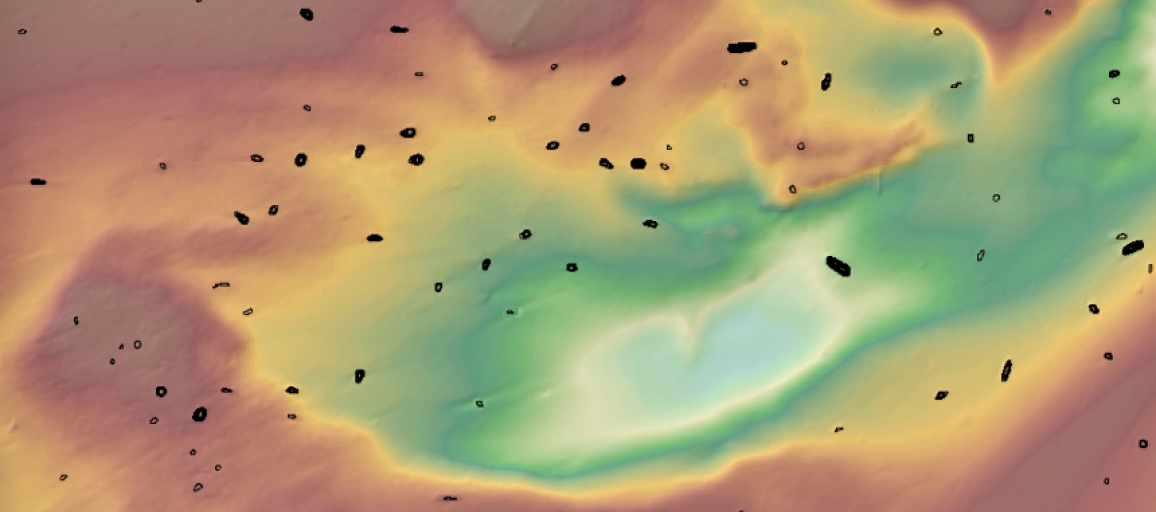
From Hydro by Dylan Davis, Dani Buffa, Amy Wrobleski
Archaeologists have long been interested in shipwrecks.
Machine learning, AI and other computerized methods of analysing imagery have made incredible strides possible in many research areas.
Bathymetry and Shipwreck Archaeology
Researchers have used bathymetric datasets to locate everything from ancient Roman and Greek vessels to World War II aircraft carriers.
Lidar (light detection and ranging) data, collected using pulses of light to record 3D surfaces, has made headlines within archaeology for its ability to detect cities hidden under jungle and forest canopies. However, there are actually two kinds of Lidar data: topographic Lidar (which is used to locate features on land), and bathymetric Lidar (which can penetrate water and map shallow ocean floors). Archaeologists have used bathymetric Lidar to detect shipwrecks in shallow waters around the world. One limitation of Lidar, however, is that the water must be calm and clear for proper data collection.
The ‘Big Data’ Problem and Underwater Archaeology
The use of 3D data like bathymetry and topography has improved researchers’ ability to detect objects in image datasets.
The use of AI and machine learning methods have become increasingly popular as they can be extremely precise, but these methods are also very complicated and require high levels of processing power to implement
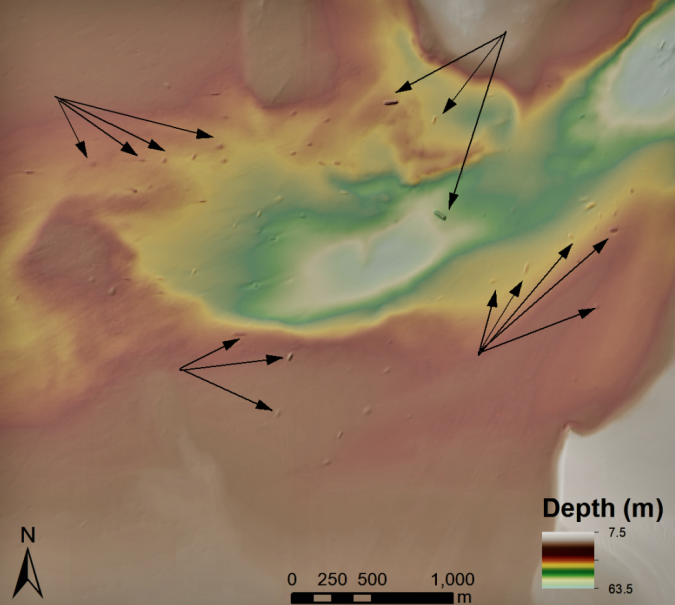 Figure 1: Shipwrecks visible in bathymetric data from the National Oceanic and Atmospheric Administration in the United States. Arrows highlight some of the larger visible shipwrecks.
Figure 1: Shipwrecks visible in bathymetric data from the National Oceanic and Atmospheric Administration in the United States. Arrows highlight some of the larger visible shipwrecks.For automated methods like machine learning and AI to work, image data must be at a fine enough resolution to detect patterns related to the target of interest.
Sinkhole Algorithms and Shipwreck Detection
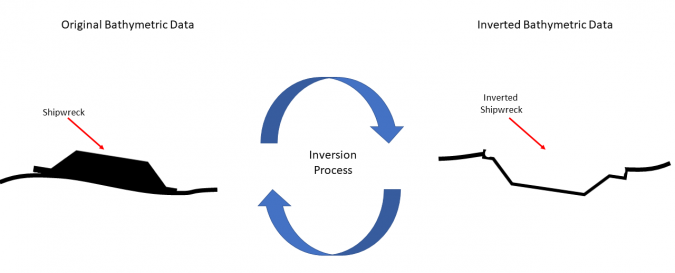 Figure 2: Illustration of how inverting bathymetric data works for detecting shipwrecks.
Figure 2: Illustration of how inverting bathymetric data works for detecting shipwrecks.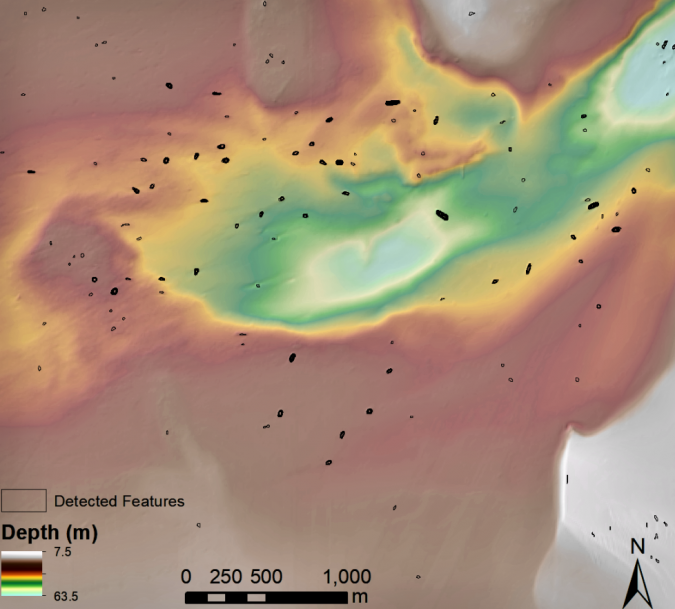 Figure 3: Example of detected shipwreck locations in the United States using sinkhole extraction algorithms. Credit: Dylan Davis, Danielle Buffa & Amy Wrobleski (2020).
Figure 3: Example of detected shipwreck locations in the United States using sinkhole extraction algorithms. Credit: Dylan Davis, Danielle Buffa & Amy Wrobleski (2020).How Useful are Automated Methods?
Because of their complexity and often imperfect results, some may wonder if using these methods is worth it.
In an automated study of shipwreck detection conducted in the United States, we found that a sinkhole extraction algorithm could detect approximately 75% of known shipwrecks within the study region. Certainly imperfect, but a pretty good initial attempt.
Conclusion
Recent research has demonstrated the potential for the automated detection of shipwrecks using mathematical models.
For those interested in using automated methods for shipwreck (or other object) detection, there are many tools available within GIS systems (including open source platforms like QGIS, WhiteBox GAT and SAGA, among others), as well as some online tutorials using ArcGIS Pro and deep learning.
Tuesday, December 28, 2021
The Philippine maritime zones
The Convention enumerated maritime zones and their entitlements.
An entitlement refers to the right to the established maritime zones.
The Philippines must reckon the point of beginning of its maritime zones from straight baselines established around the archipelago of the Philippines.
There are two methods of measuring baselines.
The first is the straight baseline method and the second is the normal baseline method.
If a baseline is drawn around an archipelago in accordance with Art.
47 of Unclos III, then it is called an archipelagic straight baseline.
In the straight baseline method, the State draws straight lines from selected points along its shoreline.
Under the normal baseline method, the low-water mark, the land that is visible during low-tide or where the sea water meets the temporary shoreline created during the low tide, is the starting point for the baseline.
In this matter, the Philippines is one of the very few States that was allowed to establish straight lines around its archipelago (if you want to have a rough idea on how the baselines of the Philippines theoretically look like, just draw straight lines on a map with the lines enclosing our archipelago).
Having established its points of beginning which are a series of straight lines, the Philippines could now reckon its maritime zones.
The first is the territorial sea which must not exceed 12 nautical miles from the baselines (one nautical mile is approximately 1,852 meters. You do the math).
The Philippines exercises sovereignty in its territorial sea as it does over its internal waters.
Not more than 24 nautical miles from the baselines is the contiguous zone.
In the contiguous zone the Philippines is not sovereign, but it could enforce its customs, fiscal, immigration and sanitary laws within the area.
Not more than 200 nautical miles from the baseline is the exclusive economic zone (EEZ).
This is the most contested area in the Law of the Sea, because within this zone, the Philippines has "sovereign rights."
It also has the right of economic exploitation and exploration, such as the production of energy from water, water current or wind.
The Philippines also has the right to establish and use artificial islands, and structures, conduct marine scientific research and the correlative duty of protecting and preserving the environment within its EEZ.
The High Seas is open to all States and all States have the right to, among others, conduct scientific explorations, fish, lay submarine cables, and fly its aircraft within the territory.
The continental shelf comprises the seabed and subsoil of the submarine area that is beyond the territorial sea, or 200 nautical miles from the baselines.
If the State is lucky because of a natural prolongation in its undersea geography (the Law of the Sea is based on geography since it starts from the land mass), then it may extend its continental shelf beyond 200 nautical miles from the baselines and such expansion if allowed by the Commission on the Limits of the Continental Shelf is called the extended continental shelf.
According to Unclos III, the Philippines exercises sovereign rights to the exploration and exploitation of the natural resources within its continental shelf and extended continental shelf.
We now go to the zone mysteriously called "The Area."
The BRP Sierra Madre lies on top of the Ayungin Shoal (a shoal is a sandbar which makes the water shallow).
One would wonder, after the Philippines was deprived of its entitlements under Unclos III due to the illegal and unauthorized actions of China, if indeed, the Law of the Sea Convention benefited us at all.
- The Manila Times : PH firm on adherence to intl laws of the sea
- IILSS : Philippines maritime claims about Archipelagic Baselines
- BusinessWorld : Mapping agency says law on PHL maritime zones long overdue
Monday, December 27, 2021
The Arctic fails its annual health check as global warming brings more ills to the region
2021 will mark one of the biggest ice melt years for Greenland in recorded history.
A report published on Tuesday, which serves as an annual physical for the Arctic, found this vast and significant biome is changing profoundly.
It continues to warm twice as fast as the rest of the Earth and is rapidly losing ice cover, transforming from a reliably-frozen landscape to a greener and browner one than it was just around a decade ago.
More than 100 scientists authored the Arctic Report Card, published by the National Oceanic and Atmospheric Administration (NOAA), and examined changes in snow cover, sea ice volume, tundra vegetation, as well as surface air and ocean temperatures from October 2020 to September 2021.
The report also describes an increase in commercial activities and ships that are venturing further into the Arctic on sea routes opened up by melting ice.
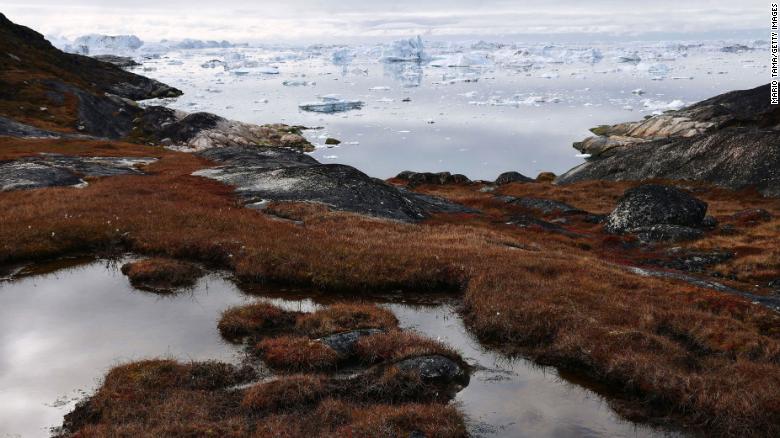
Researchers from Denmark estimated that in July of this year enough ice melted on the Greenland Ice Sheet to cover the entire state of Florida with two inches of water.
Retreating glaciers and melting permafrost also threaten lives, economies and infrastructure.
"If you recognize that the Arctic really is the gateway to climate change, and that we need some means of taking a regular pulse check on how things are in that critical area, the report card represents, if you will, a bit of a snapshot," NOAA Administrator Richard Spinrad told CNN.
"That's why it's important, just like going to your doctor for an annual physical," he added.
"You want to get a consistent, comparable set of observations."
This summer, the Greenland ice sheet experienced three extreme melt events in the period studied, according to the report.
For people who live far from the Arctic and may think of the region as something in distance, Twila Moon, the lead editor of the report and scientist with the National Snow and Ice Data Center, explains that it's all connected, especially when it comes to ice melt.
As the Greenland ice sheet thaws, that loss of ice causes sea levels to rise, which can be strongly felt in places far from the Arctic, including low-lying Pacific Islands and coastal cities.
These impacts can lead to coastal erosion, salt water intrusion in freshwater drinking resources, as well as disruptions to sewer and water systems.
In addition, the Arctic's thawing permafrost is also releasing more greenhouse gases into the atmosphere, further exacerbating the warming of the entire planet.
"The Arctic report card this year is showing us how well connected we as people are to the environmental changes happening in the globe, and how these cascading disruptions in one place is not isolated and might influence other parts of the system," Moon told CNN.
"We now live at a time that is fundamentally different from the past and will be experiencing ongoing change into the future."
A recent scientific report on the region showed that the Arctic Ocean had been warming since the onset of the 20th century, decades earlier than previously thought.
While the year studied was the seventh warmest on record in the Arctic, the period from October to December 2020 was the warmest on record.
The Arctic continues to warm more than twice as fast as the rest of the globe.
The summer also brought warmer-than-usual temperatures.
An August heatwave triggered rain to fall at the summit of Greenland instead of snow for the first time on record. As temperatures at the summit rose above freezing for the third time in less than a decade, the warm air fueled an extreme rain event that dumped 7 billion tons of water on the ice sheet.
A report published after that event found this was likely to happen more often.
The Arctic is expected to experience more rain than snow some time between 2060 and 2070, marking a major transition in its precipitation patterns as the climate crisis jacks up temperatures in the region.
"Things that happen in the Arctic don't specifically stay in the Arctic," Michelle McCrystall, climate researcher at the University of Manitoba in Winnipeg, who is not involved with the report, previously told CNN.
The NOAA report card also found, from satellite images and other data, that North American beavers are taking over the Arctic tundra of Alaska, doubling their ponds in the last two decades.
Scientists are also mapping beaver ponds in Canada and Asia.
That's an issue because beavers gnaw through and fell trees, and build dams, which can flood valleys and form new lakes that contribute to the thawing of the frozen permafrost soil.
When permafrost melts, it emits large amounts of methane, a more potent greenhouse gas than carbon dioxide.
Both the dwindling sea ice and shifting marine habitats are also bringing an uptick in shipping traffic to the Arctic.
The rise in human activity, coupled with the environmental changes it brings, is drastically altering the marine soundscape, according to the report.
"In your home, if you notice that one of your lights is flickering, you'd wonder if you got a problem with the electricity," Spinrad told CNN.
"But if you notice all the lights are flickering, the air conditioning is not working, and there are some leaks in the plumbing, you'd start saying we have a serious problem overall with the home, not just an isolated set of incidents."
Spinrad said it's the aggregation of a wetter, less icy, greener and warmer Arctic that suggests the region is fundamentally different from the one the planet has known centuries, or even decades ago.
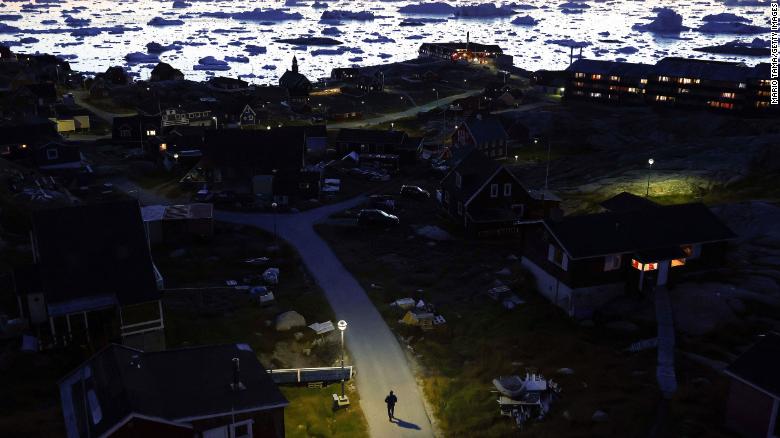
The report found that, as the planet rapidly warms, retreating glaciers and thawing permafrost are already threatening the lives of the roughly five million people living in the permafrost region of the Northern Hemisphere, creating a cascading effect through economies, infrastructure, and national security of local Arctic communities.
Glacial retreat is also exposing already arduous slopes that are prone to destabilize, which in the presence of deep water, can cause landslide-fueled tsunamis, flooding and debris flow that could potentially be deadly, the report shows.
This last year adds to another stretch of exceptionally high tundra greenness since the report began; however, recent extreme events and other local influences such melting permafrost thaw or wildfires are also priming the landscape to become browner.
Moon said that as the whole world is experiencing some level of impact from the climate crisis, people should be able to empathize with communities in the Arctic and not view the region as a disconnected place.
"The people of the Arctic are similarly experiencing extreme events and conditions that they've never before witnessed or have to deal with," said Moon.
"So on a very human scale, we are all finding ourselves in a world that is now fundamentally changed from the the environmental conditions of the last many decades and centuries."
Sunday, December 26, 2021
Greenland : where the ice meets the ocean
 Greenland in the GeoGarage platform (DGA nautical raster chart)
Greenland in the GeoGarage platform (DGA nautical raster chart)

